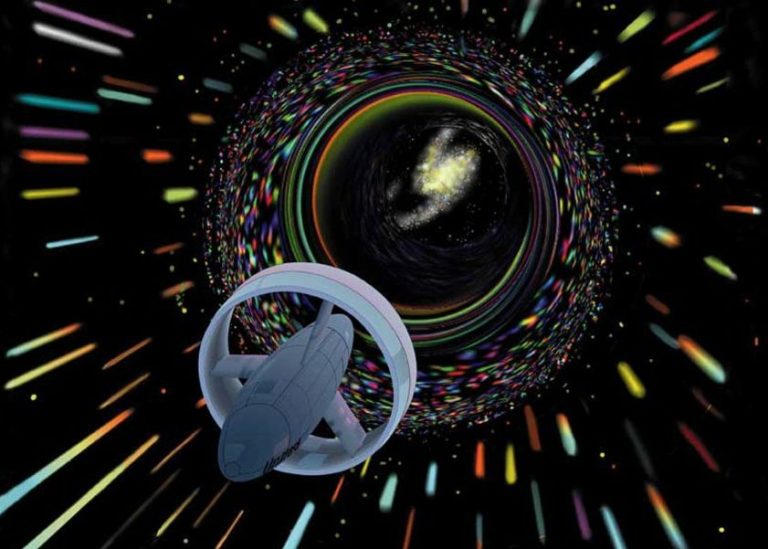Warp Drive ERP: How Warp Drives Could Generate Gravitational Waves
Key Takeaways
Warp drives have a theoretical basis in general relativity. Miguel Alcubierre proposed the concept of warp drives in 1994. Warp drives could theoretically enable faster-than-light (FTL) travel by warping spacetime. Warp drives face significant scientific barriers, including energy requirements and stability issues. The collapse of a warp drive could potentially emit gravitational waves. Current gravitational wave detectors may not be sensitive enough to detect these signals. Future advancements in gravitational wave detection could potentially identify warp drive signals.
Summary
- Warp drives, theoretically described by Alcubierre, offer a method of faster-than-light travel by warping spacetime.
- The concept faces practical barriers, including the Null Energy Condition and stability issues.
- A warp drive collapse could emit detectable gravitational waves.
- Current detectors may not be sensitive enough, but future advancements could change this.
- Theoretical work continues to explore the feasibility and implications of warp drives.
Warp Drives and Gravitational Waves
Warp drives, a concept popularized by science fiction, have a theoretical foundation in general relativity. Proposed by Mexican physicist Miguel Alcubierre in 1994, warp drives could theoretically enable faster-than-light travel by warping spacetime.
Theoretical Basis of Warp Drives
The Alcubierre Drive proposes a method for faster-than-light travel by contracting spacetime in front of a spacecraft and expanding it behind. This would create a “warp bubble” that allows the spacecraft to travel faster than light without violating the principles of relativity.
Null Energy Condition
One major obstacle to creating a warp drive is the Null Energy Condition (NEC), which states that a region of space cannot have a negative energy density. While theoretical workarounds exist, none are currently practical.
Stability Issues
Another significant challenge is maintaining the stability of the warp bubble. While the Einstein Equation can initiate a warp bubble, no known equation can sustain it. The warp bubble tends to disperse or collapse into a central point.
Detecting Warp Drive Collapses
Gravitational Waves
Gravitational waves are ripples in spacetime caused by massive objects accelerating. The collapse of a warp drive could theoretically generate gravitational waves, similar to those produced by black hole mergers or neutron star collisions.
Simulation Results
Researchers simulated the collapse of a warp bubble and found that it generates a gravitational wave signal distinct from typical binary mergers. The signal comes as a burst, followed by an oscillatory period with a characteristic frequency.
Current and Future Detection
Current gravitational wave detectors, like LIGO and Virgo, may not be sensitive enough to detect the gravitational waves from a warp drive collapse. These detectors are designed to pick up signals within a specific frequency range, and warp drive signals may fall outside this range.
Future Advancements
Proposals for higher frequency gravitational wave detectors have been made, which could potentially detect warp drive signals in the future. These advancements would allow scientists to put bounds on the existence of such signals and explore the feasibility of warp drives further.
Multimessenger Signals
In addition to gravitational waves, the collapse of a warp drive could send multimessenger signals. However, it’s difficult to predict how the matter from a warp drive would interact with regular matter.
Theoretical Implications
The research into warp drives and their potential gravitational wave signals is still in its early stages. The current models have several theoretical problems that need to be addressed. Future research will focus on understanding the signatures of warp drive signals and characterizing their detectability.
Conclusion
Warp drives remain a fascinating theoretical concept with the potential to revolutionize space travel. While significant scientific barriers exist, ongoing research continues to explore their feasibility and implications. The detection of gravitational waves from warp drive collapses could provide valuable insights into the nature of spacetime and the possibilities of faster-than-light travel.
Tables
Table 1: Key Scientific Barriers to Warp Drives
| Barrier | Description |
|---|---|
| Null Energy Condition (NEC) | States that a region of space cannot have a negative energy density |
| Stability Issues | Maintaining a stable warp bubble over time is currently not feasible |
| Energy Requirements | Theoretical models require enormous amounts of energy to create a warp bubble |
Table 2: Gravitational Wave Detection
| Detector | Frequency Range | Sensitivity to Warp Drive Signals |
|---|---|---|
| LIGO | 10 Hz to 1 kHz | Low |
| Virgo | 10 Hz to 1 kHz | Low |
| Future Detectors | Higher Frequencies | Potentially High |
References
- Clough, K., Dietrich, T., & Khan, S. (2024). What no one has seen before: gravitational waveforms from warp drive collapse.
- Alcubierre, M. (1994). The warp drive: hyper-fast travel within general relativity. Classical and Quantum Gravity.

